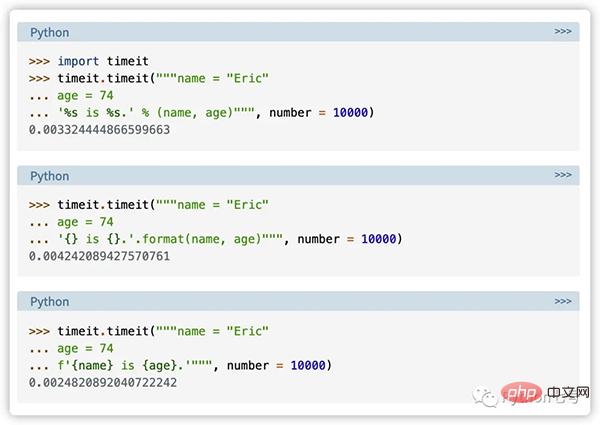Python 的 f-strings 作用遠遠超出你的預期
- 王林轉載
- 2023-04-18 19:22:031377瀏覽

學過Python 的朋友應該都知道f-strings 是用來非常方便的格式化輸出的,覺得它的使用方法無外乎就是print(f'value = { value }',其實,f-strings 遠超你的預期,今天來梳理一下它還能做那些很酷的事情。
1、懶得再敲一遍變數名稱
str_value = "hello,python coders"
print(f"{ str_value = }")
# str_value = 'hello,python coders'2.直接改變輸出結果
num_value = 123
print(f"{num_value % 2 = }")
# num_value % 2 = 13、直接格式化日期
import datetime
today = datetime.date.today()
print(f"{today: %Y%m%d}")
# 20211019
print(f"{today =: %Y%m%d}")
# today = 20211019
4、2/8/16 進位輸出真的太簡單
>>> a = 42
>>> f"{a:b}" # 2进制
'101010'
>>> f"{a:o}" # 8进制
'52'
>>> f"{a:x}" # 16进制,小写字母
'2a'
>>> f"{a:X}" # 16进制,大写字母
'2A'
>>> f"{a:c}" # ascii 码
'*'
5、格式化浮點數
>>> num_value = 123.456
>>> f'{num_value = :.2f}' #保留 2 位小数
'num_value = 123.46'
>>> nested_format = ".2f" #可以作为变量
>>> print(f'{num_value:{nested_format}}')
123.466、字串對齊,so easy!
>>> x = 'test'
>>> f'{x:>10}' # 右对齐,左边补空格
'test'
>>> f'{x:*<10}'# 左对齐,右边补*
'test******'
>>> f'{x:=^10}'# 居中,左右补=
'===test==='
>>> x, n = 'test', 10
>>> f'{x:~^{n}}' # 可以传入变量 n
'~~~test~~~'
>>>7、使用!s,!r
>>> x = '中'
>>> f"{x!s}" # 相当于 str(x)
'中'
>>> f"{x!r}" # 相当于 repr(x)
"'中'"8、自訂格式
class MyClass:
def __format__(self, format_spec) -> str:
print(f'MyClass __format__ called with {format_spec=!r}')
return "MyClass()"
print(f'{MyClass():bala bala%%MYFORMAT%%}') 輸出如下:
MyClass __format__ called with format_spec='bala bala%%MYFORMAT%%' MyClass()
最後
Python 的f-string 非常靈活優雅,同時還是效率最高的字串拼接方式:

以後關於字串的格式化,就f-string 了。如果覺得有收穫,也請按讚、在看、關注,感謝支持!
以上是Python 的 f-strings 作用遠遠超出你的預期的詳細內容。更多資訊請關注PHP中文網其他相關文章!
陳述:
本文轉載於:51cto.com。如有侵權,請聯絡admin@php.cn刪除

